We have an image problem.
In experimental evolution, Drosophila (the humble fruit fly) is often used to demonstrate evolutionary processes. It is used because genetic changes for the fruit fly can be observed very quickly in response to natural selection. In business, the equivalent of the fruit fly is the IT or information technology company, such as Xero or the Wynyard Group.
IT companies form the bulk of case studies in management texts and innovation case studies because they are quick to respond to changing market conditions, and also quick to demonstrate these changes in the market. They are perfect examples of rapid innovation.
In contrast, the steel industry is perceived to be traditional, slow to innovate and slow to respond to changing market conditions. We’re not rolled out as case studies for innovation and we are often relegated to the categories of at worst ploddingly ‘low-tech’, or at best masters of ‘incremental innovation’.

We’re not attractive for Government funding either because we aren’t exciting in terms of being able to demonstrate rapid change, hi-tech outcomes or capturing public imagination. In other words, we’re “innovation dinosaurs”. The most public excitement we generate is speculation on whether or not we will die out or find a way to survive in the new world.
There is no doubt that the world is changing and so we need to adapt and quickly. However, we are not going to turn into hi-tech, fast innovating firms any time soon. The question is how do we show the world we are adapting in a way that is meaningful and be excited about our evolutionary journey, albeit relatively slow-paced?
We need to demonstrate value.
We might not be doubling our revenue year on year but we do make a consistent and substantial contribution to the New Zealand economy. For example, New Zealand Steel alone contributes ~1% of GDP. The New Zealand metals manufacturing industry employs around 26,000 Kiwis.
Together, we contribute significantly to employment, import replacement and export. This means that investing a dollar in incremental transformation of the steel industry is likely to yield more value to the economy than investing a dollar in any radical innovation arising from an emerging high-tech but volatile IT industry.
Certainly, studies of OECD countries show that growth is primarily based on the transformation of existing sectors vs new sectors, and the contribution of hi-tech industries is over-emphasised.
We need to find a way to better promote our innovation.
Incremental innovation can be sexy too – we just need to articulate the story better. We need to tell it in a way that emphasises the longevity of the industry and the evolutionary time scales we work within. We can’t be compared to IT companies – they don’t tend to have long lives. They metabolise like shrews, all frenzied and short-lived. We metabolise like sloths, stead-fast and enduring.
Yet, a fast-paced sloth is more newsworthy than a fast-paced shrew. That is, let’s focus on the steel industry in NZ bucking the global trends for steel innovation. What are we doing that is faster or better than the rest of the world? What is the story we can tell that makes us more newsworthy?
We have to change the perception of our industry
If we want more air time with politicians; funding agencies; customers and the general public, we have to change the perception that we are a low-skilled, old-fashioned, slow-to-evolve, traditional industry.
Other traditional industries, such as the timber industry, have been pretty good at telling their stories. Our story is arguably even more compelling, certainly in terms of innovation, so let’s start telling it in a way that identifies us as the new leaders of the old low-tech. That is, let’s finally be seen as the steadfast economic contributor who is managing to re-invent itself to maintain currency.
In summary, to develop a new public persona for the NZ steel industry, we need to dress ourselves up; more like a glamourous, racing emo (you know, nouveau punk) shrew/fruit fly than a tweed-jacketed-with-brown-leather-elbow-patches, sedentary sloth/dinosaur (talk about mixed metaphors!). We are there in principle and we’re still going strong; we just need to make sure we update our wardrobe when we go out in public!
“Apple hasn’t so much invented new as they have innovated (to converge technologies into well-built and -designed packages).” David Reiss, Spark Digital
